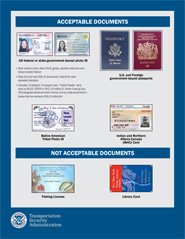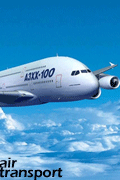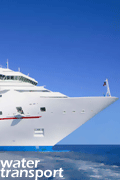|
posted by transport blogs
@ 12:40 AM
permanent link |
|

Flight services in the UK are made up of various services provided by airport operators, tour companies and airlines as well as government bodies. Airports are managed by different groups depending on the activity concerned. Main UK airports and their responsibilitiesBAA (formerly the British Airports Authority) owns and operates seven British airports. They are: London Heathrow, London Gatwick, London Stansted, Aberdeen, Edinburgh, Glasgow and Southampton. Within these airports, the airlines are responsible for: - hold baggage handling (from check-in through to delivery at final destination)
- provision and fuelling of the aircraft
- boarding of passengers (including those with special needs)
However, many airlines contract out services such as baggage handling and catering. HM Revenue and Customs is responsible for the import/export of goods. The Home Office Border and Immigration Agency (BIA) is responsible for passport control and asylum issues. National Air Traffic Services (NATS) is responsible for air traffic control in British airspace. Public transport operators run services to and from the airports. Regulating airlines and flightsThe Civil Aviation Authority (CAA) is the UK’s aviation regulator, controlling all flight paths and aircraft routes at UK airports. The CAA regulates airlines, airports and NATS and is also responsible for setting airport charges at the London airports. New security regulationsThe Department for Transport issued new restrictions on hand baggage in November 2006. The regulations cover what can and cannot be taken through security and apply to anyone travelling from any UK airport. The regulations are stricter than they used to be so it may take you longer to get through security. Labels: travel and transport
              
posted by transport blogs
@ 10:42 PM
permanent link |
|

WASHINGTON, D.C. - Mediation aimed at ending an ongoing contract dispute between the Federal Aviation Administration (FAA) and the National Air Traffic Controllers Association (NATCA) began yesterday. Both parties signed a process agreement to move the negotiations forward as planned. The agreement provides for extensive mediation sessions and for binding resolution of any unresolved issues, guaranteeing a new collective bargaining agreement between the parties.
"One of my highest priorities, since coming to DOT, has been to resolve this issue so that we can move forward to make our commercial aviation system even better than it already is,"Transportation Secretary Ray LaHood said in a recent announcement that Jane Garvey, former FAA Administrator, would lead the mediation team.
Garvey will lead the mediation as part of a three-member panel that will also include Mediators Richard Bloch and George Cohen, who have extensive experience in mediating high profile disputes.
It is expected that the expedited mediation process will continue through early June 2009. At the request of the mediators, and as is customary with all mediation processes, the details will remain confidential until the process reaches its conclusion, although the mediators will release updates to the parties during the process. Labels: FAA and NATCA Start Mediation Talks
              
posted by transport blogs
@ 10:46 PM
permanent link |
|

U.S. Transportation Secretary Ray LaHood announced that the U.S. Department of Transportation (DOT) is proposing to rescind plans for slot auctions at New York-area airports. Under the proposal, the Department would halt plans announced last October to withdraw a number of slots from airlines operating at airports in the New York region and auction the slots to the highest bidder.
"We're still serious about tackling aviation congestion in the New York region," Secretary LaHood said in New York City in remarks to the Association for a Better New York. I'll be talking with airline, airport and consumer stakeholders, as well as elected officials, over the summer about the best ways to move forward."
The plans for the auctions for slots at New York's JFK and LaGuardia Airports and Newark Liberty International Airport were announced by the Department on Oct. 10, 2008. The auctions were proposed as part of a plan to reduce congestion and delays at the region's airports, along with caps on the number of flights per hour at each of the airports. Due to litigation over the rule and a court-ordered stay, the auctions have not taken place.
In proposing to rescind the auctions, the Department noted that the rulemaking was highly controversial and that most of those filing comments opposed the slot auctions. The Department also noted that circumstances have changed since the rules were issued, including changes in the economy. Labels: Air Transportation
              
posted by transport blogs
@ 6:06 AM
permanent link |
|

The seven largest network airlines, as a group, reported an operating loss margin of 6.7 percent in the fourth quarter of 2008, the fifth consecutive quarterly loss margin since the group reported a profit margin in the third quarter of 2007, the Bureau of Transportation Statistics (BTS) of the U.S. Department of Transportation reported today in a release of preliminary data.
BTS, a part of the Research and Innovative Technology Administration, reported that six of the seven reporting network airlines, most of the industry's largest carriers, reported an operating loss margin in the October-to-December period. Only Alaska Airlines reported an operating profit.
The low-cost and regional airlines groups both reported operating profit margins for the fourth quarter. Only low-cost Virgin America and regional ExpressJet Airlines reported loss margins. Virgin America with fourth quarter revenue exceeding $100 million is included in this release for the first time this quarter.
Operating margin measures profit or loss as a percentage of the airline's total operating revenue.The seven network airlines spent 30.2 percent of their operating expenses in the fourth quarter of 2008 on fuel, compared to 13.5 percent five years earlier in the fourth quarter of 2003.
The total industry collected $498.6 million in excess baggage fees in the fourth quarter of 2008, up 42 percent from the $350.1 million collected in the third quarter and up 301 percent from the $124.2 million collected in the fourth quarter of 2007. Passenger revenue for the 21 airlines in this press release declined $4.2 billion from the third quarter to fourth quarter in 2008.
Operating Margins
The seven network carriers posted a loss margin of -6.7 percent in the fourth quarter with a combined operating loss of $1.684 billion. In the fourth quarter of 2007, the seven network carriers reported an operating loss margin of -1.1 percent with a combined loss of $274 million.
The top three operating profit margins were reported by low-cost carriers Allegiant, Spirit and AirTran Airlines. Low-cost carrier Virgin America and network carriers Northwest Airlines and United Airlines reported the largest operating loss margins.
Network carriers operate a significant portion of their flights using at least one hub where connections are made for flights on a spoke system. Low-cost carriers are those that the industry recognizes as operating under a low-cost business model, with lower infrastructure and aircraft operating costs. Regional carriers provide service from small cities, using primarily regional jets to support the network carriers' hub and spoke systems. The selected groups consist of those airlines in each group with the highest reported operating revenue in the most recent 12-month period.
Fuel Expenses
The seven reporting network carriers spent 4.89 cents per available seat-mile (ASM) for fuel in the fourth quarter of 2008, down from 6.20 cents per ASM in the third quarter.
Network airlines Northwest and United and regional carrier American Eagle Airlines spent the most for fuel per ASM while regional carriers ExpressJet and SkyWest Airlines and low-cost carrier Virgin America spent the least.
Low-cost airlines Allegiant Air and JetBlue Airways and network airline Northwest spent the largest portion of their operating costs for fuel while regionals ExpressJet and Horizon Air and network carrier US Airways spent the least.
Unit Costs
The seven network carriers reported unit costs of 16.2 cents per ASM in the fourth quarter of 2008 up from 14.5 cents per ASM in the fourth quarter of 2007.The carriers with the highest unit costs were regional airlines Comair and Horizon and network airline Northwest. The lowest unit costs were reported by regional carrier ExpressJet and low-cost carriers Allegiant and Spirit.
Unit Revenues
The seven network carriers' unit revenues in the fourth quarter of 2008 were 15.2 cents per ASM compared to 14.4 cents in the fourth quarter of 2007.
The highest unit revenues were reported by regional carriers Comair, Horizon and American Eagle. The lowest unit revenues were reported by regional carrier ExpressJet and low-cost carriers Spirit and Virgin America. US Airways reported the highest unit revenues of any network airline
Passenger Yield
The seven network airlines' passenger yield was 13.3 cents per revenue passenger-mile (RPM) in the fourth quarter of 2008, up from 12.9 cents per RPM in the fourth quarter of 2007. The fourth quarter of 2008 marked the first time since BTS began reporting yield statistics in the second quarter of 2002 that the network airlines' passenger yield fell below that of the low-ost carriers. Passenger revenue yield measures passenger revenues against total travel by dividing passenger revenues by RPMs.
The top passenger revenue yields were reported by regional carriers Comair, Horizon and American Eagle. The lowest passenger revenue yields were reported by regional carrier ExpressJet and low-cost carriers Allegiant and Spirit. Continental Airlines reported the highest passenger yield of any network carrier. Labels: Fourth-Quarter 2008 System Airline Financial Data
              
posted by transport blogs
@ 11:28 PM
permanent link |
|

The Federal Aviation Administration (FAA) has selected Alexandria International Airport, in Alexandria, LA, and Phoenix/Mesa Gateway Airport in Mesa, AZ, to participate in the 2009 Military Airport Program (MAP), which uses federal funds to convert former military airports to civilian or joint-use airports. The MAP funding, a set aside of the Airport Improvement Program (AIP), provides a boost to civilian aviation capacity by upgrading former military airports.
The airports selected this year have participated in the program before and remain committed to ensuring that critical airport projects are completed so their respective airports can operate safely and efficiently as civilian facilities.
Alexandria International Airport (AEX), a commercial service airport, will participate in the program for another three years. The MAP funds will allow AEX to replace the aging former Air Force fueling facility. The existing facility is archaic by today's commercial standards. The replacement of this facility, along with those projects already completed, will bring the airport to current civil design standards.
Phoenix/Mesa Gateway (IWA) will receive funds for an additional three years to complete additional terminal area projects due to the rapid growth at this non-hub commercial service airport. In late 2007, Allegiant Air began air service at IWA and within two months the airport had 21,103 passenger boardings. In the first nine months of 2008, there were 120,150 passenger boardings with the planes 88 percent full.
The MAP funding set aside is $23.7 million for all the airports participating in the program for fiscal year 2009. The type of projects that compete for MAP funding include building or rehabilitating parking lots, fuel farms, hangars, utility systems, access roads, and cargo buildings. Labels: 2009 Military Airport Program Selections
              
posted by transport blogs
@ 11:22 PM
permanent link |
|

posted by transport blogs
@ 4:35 AM
permanent link |
|

posted by transport blogs
@ 1:35 AM
permanent link |
|

|
![]()
![]()











